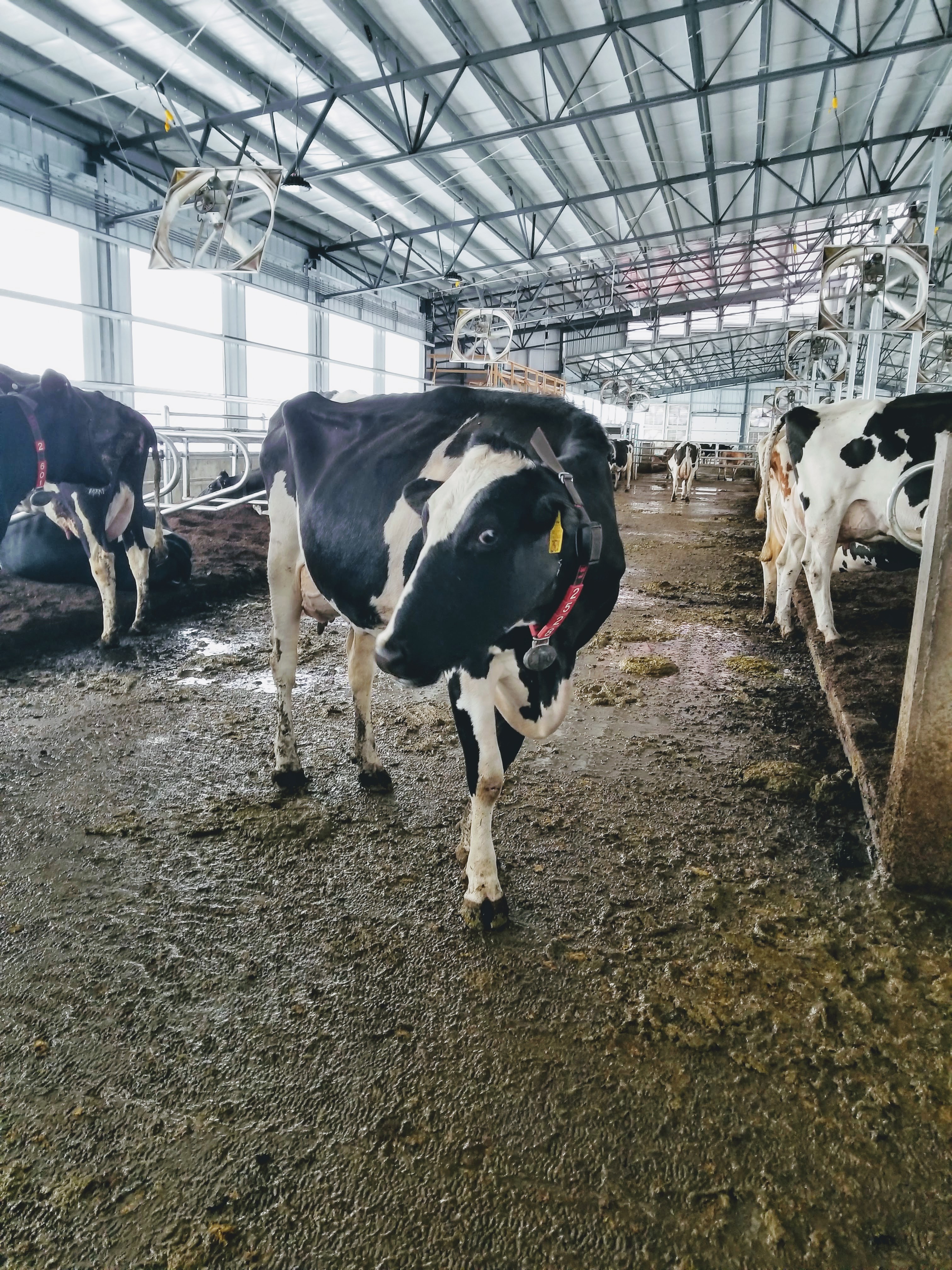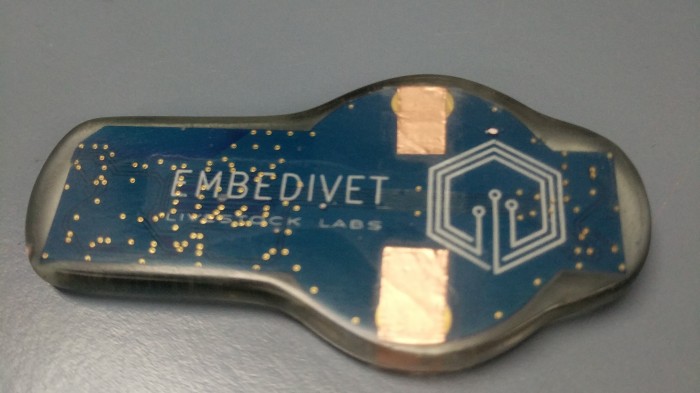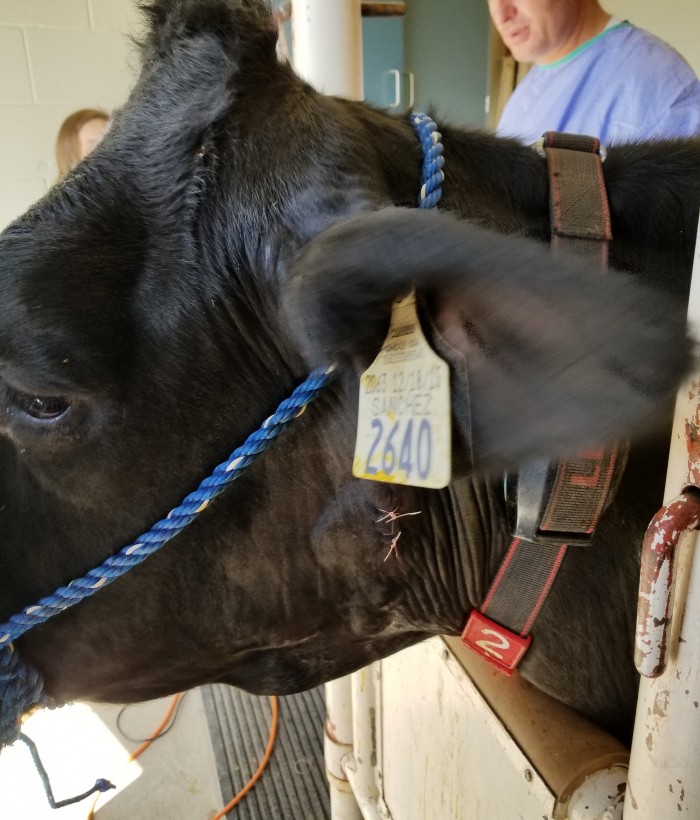Subcutaneous Fitbits? These cows are modeling the tracking technology of the future

Somewhere on a dairy farm in Wellsville, Utah, are three cyborg cows, indistinguishable from the rest of the herd.
Just like the other cows, they eat, drink, and chew their cud. Occasionally, they walk over to a big, spinning red-and-black brush, suspended at bovine back height, for a scratch. But while the rest of the cows just get their scratch and move on, these cows deliver data. Trackers implanted in their bodies use low-energy Bluetooth to ping a nearby base station and transfer information about the cows’ chewing frequency, temperature, and general rambling around the farm.
These cows are the first to try a device called EmbediVet, created by a startup named Livestock Labs. For now, they’re just going about their normal lives, unintentionally providing data that helps train an artificial neural network. The hope is that in the near future, this AI will help farmers figure out quickly and easily how well cows and other livestock are eating, whether they’re getting sick or about to give birth—things that are typically done today just by watching and waiting but are difficult to spot when you’ve got hundreds or thousands of animals to keep an eye on.
Embedded RFID sensors and other trackers have long been used in livestock, though generally just for identifying each animal. There are already some behavior-tracking wearables out there, such as collars, that use sensors to pinpoint events like cud-chewing and illness. But Livestock Labs claims that once EmbediVet is implanted—currently in a surgical procedure done under local anesthetic—it’s less annoying to the cow than a wearable and, potentially, a more powerful way to collect useful data and spot bovine behavior patterns over time.
This subcutaneous tracker actually had a human tryout before it even got anywhere near a cow. And its creator hopes to eventually bring the cow-tested technology back under your skin.

Tried in humans, retooled for cattle
Livestock Labs CEO Tim Cannon never set out to make what is, in essence, an embedded Fitbit for cows. What he really wanted was to use the same technology to reengineer himself, and anyone else who wanted to do likewise.
Cannon, a software developer and biohacker, took his first plunge into surgically upgrading himself in 2010 after seeing a video of a Scottish biohacker named Lepht Anonym talking about the sensations produced by a magnet she implanted in her finger. Shortly thereafter, he got his own finger magnet and cofounded Grindhouse Wetware, a biohacking startup in Pittsburgh that focuses on designing and building implantable electronics.
For years at Grindhouse, Cannon and his team made several sensors, including a device called Circadia, which included a thermometer and LED lights that glowed from beneath the skin.
Cannon hoped Circadia could collect data and work with AI software he built to start predicting illnesses. And in 2013, after about a year of work and $2,000 in development costs, he had a Circadia sensor surgically implanted into his arm.
“When we did this, we were actually trying to throw down a glove to the medical industry, to technological fields, to say, ‘Look, if a bunch of idiots in a basement can do this while smoking joints and listening to Wu Tang, what the fuck is the problem?’” Cannon says.
The problem, it seems, is that beyond a small community of hackers, grinders, and curious observers, most people just aren’t interested in having things implanted in their bodies, especially if these things aren’t medically necessary.
Grindhouse tried selling the implants it created, but it wasn’t making money. It couldn’t pull in any investors, so Cannon and others were funding the work themselves with their day jobs. They grew aware of the enormous regulation challenges they faced if they wanted to make non-essential implants for humans, he says, and realized that the job would undoubtedly include years of work and millions of dollars.
Then, last spring, an Australian biohacker named Meow-Ludo Disco Gama Meow-Meow (yes, really) contacted Cannon with an idea. A tech incubator in Sydney, Cicada Innovations, was about to launch a program that focused on helping build agricultural food technology companies (the country has a large livestock industry, with about 25.5 million cattle). How about putting sensors in cows instead of people?
It was like a “Duh, it’s obvious” moment, Cannon says. His new venture, dubbed Livestock Labs, was accepted to Cicada’s GrowLab program. In September, Cannon moved to Sydney from his home in Pittsburgh, and soon started working with a small team to remake the Circadia sensor from scratch into one that could be implanted in farm animals.
Within months, Livestock Labs readied a new device—now called EmbediVet—for testing in cattle. Covered in a clear resin, it includes an ARM processor and Bluetooth and long-range radios, as well as a thermometer, accelerometer, and heart-rate monitor and pulse oximeter for measuring heart rate, blood oxygen levels, temperature, and basic activity. It runs on a coin-cell battery the company expects will last for about three years.
On the farm
On April 3, Kerry Rood, an associate professor at Utah State University’s School of Veterinary Medicine, implanted a series of EmbediVet sensors in three cows on the school’s dairy farm: two in the left side of the lower jaw, and one between two ribs. (Since there’s not much existing data about the best places for implanted activity trackers in cattle, and Livestock Labs wants to log chewing and rumination, these seemed like good starting points.)
To perform this minor surgery, Rood gave the cows local anesthesia, sliced their hide in the proper spots, slipped in an EmbediVet prototype, and stitched them up. Over a month later, he says, they’re tolerating the implants well.

Why do it? Rood thinks that this kind of device can be more accurate than a wearable one such as a collar or an anklet, especially when it comes to tracking a metric like body temperature, which correlates with disease, in thick-skinned animals.
To check out the early data, Cannon says, he’s built some charting software that can pull in what’s gathered from the cows’ EmbediVet devices and plot it out. Eventually, Livestock Labs intends for farmers to use a smartphone app to check out their animals’ status and see alerts about issues.
“As a veterinarian, if there’s some way I can detect animal diseases, animal discomfort, earlier, then I’m ahead of the ballgame when it comes to providing care and welfare to these animals,” Rood says.
Beyond the work Livestock Labs is doing with Rood, Cannon says, other research trials are in the works with Charles Sturt University and the University of New England, both in Australia, as well as trials with some commercial farmers he won’t name. He hopes EmbediVet will be available in a public beta test next March.
“We stumbled onto something that was a lot bigger and more in demand than we thought, in this particular sector of the world,” Cannon says.
Ryan Reuter, an associate professor of animal science at Oklahoma State University who studies beef cattle, thinks the tracker could be quite useful. He cautions, however, that there are a lot of factors to consider with its design. For instance, cows are big and strong and like to rub on things (such as that aforementioned back scratcher), so anything implanted in them needs to be rugged enough to hold up to abuse. It also needs to stay in place, he says, especially with animals being raised to be eaten.
“That would be important in food animals, so you make sure that you put the implant somewhere that it has no chance of ending up in a food product for humans,” he says.
There’s also the issue of pricing, since margins in dairy and beef cattle production are slim. The components of EmbediVet cost $20 right now, Cannon says, but it’s not clear what the eventual price will be; Reuter says that somewhere in the range of $10 or $20 a cow would get beef or dairy farmers interested.
Back to you, humans?
These days, Cannon splits his time between Pittsburgh and Sydney. Livestock Labs has $2 million in early funding from Australia’s livestock industry group, Meat & Livestock Australia (which is also a GrowLab partner), and additional funds from individual investors in the US.
For now, he’s concentrating on making sure that the implants aren’t causing any unintended consequences with the cyborg bovines.
“They are developing a slight urge to destroy humanity,” he jokes, “but we’re monitoring it.”
Joking aside, Cannon is serious about one goal that’s far beyond anything his startup may do to help farmers and their livestock. He says he also hopes the company gets people more comfortable with the idea of bodily implants in general. He is adamant that one day he will return to offering sensors to people—though he’s not sure if it will be a totally new company or a “human line” from Livestock Labs.
The second option, he admits, might be “just a little bit too much for people.”
Deep Dive
Humans and technology
Building a more reliable supply chain
Rapidly advancing technologies are building the modern supply chain, making transparent, collaborative, and data-driven systems a reality.
Building a data-driven health-care ecosystem
Harnessing data to improve the equity, affordability, and quality of the health care system.
Let’s not make the same mistakes with AI that we made with social media
Social media’s unregulated evolution over the past decade holds a lot of lessons that apply directly to AI companies and technologies.
Stay connected
Get the latest updates from
MIT Technology Review
Discover special offers, top stories, upcoming events, and more.